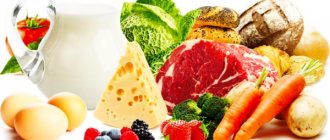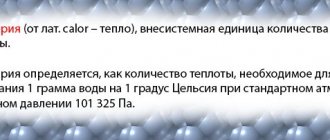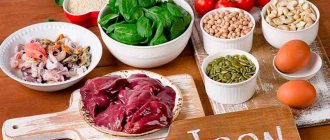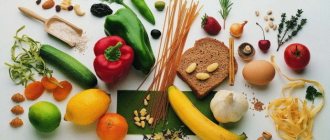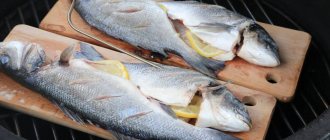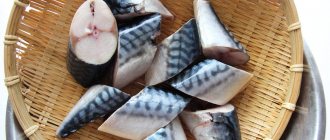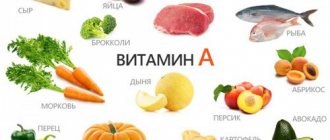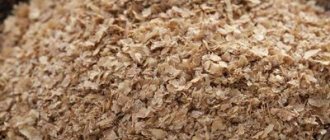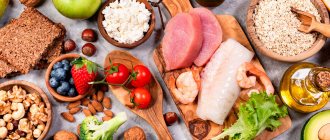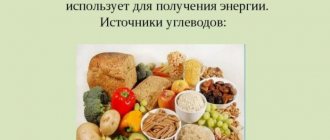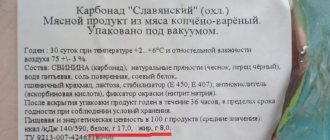Every person interested in healthy eating has heard and read more than once about the importance of protein, which is often called the basis of life. This is not an exaggeration, but a reality that corresponds to reality. When monitoring your diet, you should always take into account that the amount of protein in it should be at least 30%. A similar number should be for fats, and carbohydrates - 40%.
Drawing up a balanced menu requires knowledge of which foods contain the most protein and how to correctly calculate the daily requirement. In addition, an important aspect of a proper diet is the proper combination of foods with each other.
In meat
Meat is a truly valuable source of protein that is easily absorbed by the body. The great advantage of meat over other products is the large selection of cooking methods and the ease of consuming it in large quantities, which is very important in those moments when it is necessary to quickly replenish protein reserves in the body.
The table shows data on the protein content per 100 grams:
| Mutton | 24g |
| Lean lamb | 21g |
| Beef lean | 20.2g |
| Beef (minced meat) | 23g |
| Goose | 29g |
| Turkey (lean) | 24g |
| Rabbit, hare | 24g |
| Chicken (without skin) | 25g |
| Chickens (broilers) | 22.6g |
| Pork is fatty | 19g |
| Pork lean | 25g |
| Fatty veal | 20g |
| Skinny veal | 22g |
| Duck | 17.6g |
Protein in organ meats
In meat by-products, protein is preserved almost completely , but at the same time they sometimes contain a higher content of fats, carbohydrates, calcium and other useful microelements. Meat and its meat products are products with a high protein content.
The table below shows average values based on content per 100 grams:
| Chicken liver (broil) | 18-21 |
| Chicken heart (broil) | 15-22g |
| Chicken stomachs | 20-22g |
| Beef brains | 11g |
| Lamb liver | 19g |
| Beef liver | 17g |
| Pork liver | 18g |
| Lamb kidneys | 12.5g |
| Beef kidneys | 12.5g |
| Pork kidneys | 14g |
| Lamb heart | 14g |
| Beef heart | 15g |
| Pork heart | 15g |
| Sausages | 10-20g |
| Beef tongue | 16g |
How much protein is in milk and dairy products?
Milk is a natural source of a whole range of beneficial substances. It is not surprising that the protein content in milk and dairy products is very high.
Protein content per 100g of product:
| Brynza | 18g |
| Kefir (yogurt) 0.1-1% | 3g |
| Milk 0.1-1% | 33g |
| Milk 1.5-5% | 3g |
| Buttermilk | 3.3g |
| Cream | 2.8g |
| Sour cream | 1.5g |
| Hard cheeses (medium) | 25-35g |
| Dutch | 26.0g |
| Kostroma | 25.2g |
| Poshekhonsky | 26.0g |
| Lithuanian | 29.0g |
| Smoked sausage | 23.0g |
| Processed cheese | 20g |
| Cottage cheese 0.6% | 16g |
| Cottage cheese 20% | 14g |
This is due to the fact that manufacturers add proteins and carbohydrates to many dairy products themselves. Be sure to carefully read the product packaging.
Protein intake standards for women, men and children
The norm tables reflect the daily requirement for protein from natural foods.
Protein intake depends on:
- gender - the female norm is generally less than the male norm.
- age - in children and pregnant women the norms are higher;
- Activity categories —people who lead a sedentary lifestyle need less protein. The highest standards are for athletes, especially those who are working to increase muscle mass.
- body constitution - overweight and physically developed people require more protein.
- doctor's recommendations - nutritionist for health reasons.
Daily protein intake:
| Category | Norm, g |
| children from birth to 3 years | 1-1.5 per 1 kg of weight |
| children from 4 to 13 years old | 0.9 per 1 kg of weight |
| children 8–13 years old | 95 |
| girls 14–17 years old | 92 |
| boys 14–17 years old | 107 |
| girls 18–25 years old | 96 |
| boys 18–25 years old | 113 |
| pregnant women (5–9 months) | 109 |
| nursing mothers | 113 |
Consumption standards for persons 40–60 years of age and pensioners:
| Types of activity, lifestyle | Norm for women, g | Norm for men, g |
| not related to physical activity | 75 | 89 |
| with low physical activity | 77 | 92 |
| with significant physical activity | 79 | 93 |
| with high physical activity | 85 | 100 |
| retirement age | 68 | 75 |
When vital activity or body weight changes, consumption rates should be adjusted.
In the egg
Many athletes of the past, before the invention of special dietary supplements, were recommended by trainers to drink 3-5 raw eggs before training. It was believed that in this way the athlete received a high dose of proteins, and the muscles tired more slowly and grew faster.
| Whole egg (100 g) | 12g |
| Egg, yolk (1 pc.) | 2.7g |
| Egg, white (1 pc.) | 3.6g |
As can be seen from the table, the coaches’ advice was only partly correct. The same chicken contains much more protein, but it will take almost 5 times longer to digest.
In fish
The protein content in fish is lower than in meat, but fish is rich in other useful substances that cannot be obtained from meat (a prime example is phosphorus), plus fish is a dietary product.
Values are based on protein content per 100 grams.
| Beluga | 24g |
| Pink salmon | 21g |
| Flounder | 18.2g |
| Carp | 19.9g |
| Mullet | 21.4g |
| Icy | 17.4g |
| Bream | 21g |
| Macrurus | 15.3g |
| Pollock | 17g |
| Sea bass | 20g |
| Sturgeon | 16.5g |
| Blue whiting | 17.9g |
| Saber fish | 20g |
| Saira | 18.6g |
| Salaka | 18.0g |
| Sardine | 23.7g |
| Herring | 15.5g |
| Salmon | 16.3g |
| Smoked salmon | 25.4g |
| Whitefish | 19g |
| Mackerel | 18g |
| Horse mackerel | 18.5g |
| Sterlet | 17g |
| Som | 17g |
| Zander | 21g |
| Trepang | 7.0g |
| Cod | 17g |
| Smoked cod | 23.5g |
| Tuna | 23g |
| coal fish | 14g |
| Trout | 15.5g |
| Hake | 16.6g |
| Pike | 18g |
| Ide | 18.2g |
The benefits and harms of animal protein
There is still no consensus in the scientific community about the benefits or harms of products containing animal protein.
Plant food, after being broken down in the digestive system of an animal, forms cellular protoplasm.
Long-term laboratory studies confirm that protoplasm does not contain substances that cause aging.
Therefore, some scientists are convinced that the main cause of ailments and aging is contamination of the cellular protoplasm of the body, disruption of its natural structure.
The list of animal protein products contains meat, meat foods. It helps you lose weight or build muscle. But eating animal protein causes blockages that lead to disease. If the protoplasm is heavily contaminated, the body ages rapidly due to disruption of cellular processes.
The body spends up to 60-70% of the energy received on digesting animal protein foods. Such energy expenditure is especially undesirable in case of serious illness.
Some scientists believe that initially primitive man ate exclusively fruits, tubers, and nuts. Only after mastering fire did he begin to consume meat products that contain animal protein.
Carnivorous animals eat raw meat. The human body still does not know how to quickly digest and remove lifeless mass from the body - the result of heat treatment of meat.
Processing meat food requires significant effort from the digestive system, which wears it out faster. The body digests meat up to 8 hours, plant foods - twice as fast.
The breakdown of animal protein forms uric acid, which causes gout, rheumatism, and headaches.
According to legend, one of the methods of execution in Ancient China was to feed the criminal exclusively boiled meat. After a month or two, the kidneys could not cope with the elimination of protein waste, which led to poisoning.
Removing one gram of waste from animal protein foods requires up to 40 g of water, which increases the load on the kidneys.
It has been proven that products containing animal protein decompose twice as fast as plant foods.
Before death, the animal experiences stress, which causes harmful substances to penetrate into the meat. Eating it increases blood pressure, causes spasm and atherosclerosis of blood vessels.
Modern research confirms that abuse of foods containing animal protein contributes to the development of kidney stones.
Lean meat contains nitrogen-containing compounds. They contain significant amounts of by-products and broths. They excite the nervous system, stimulate the release of digestive enzymes and gastric juice, more irritate the gastric mucosa, and increase the load on the kidneys. Disturbs memory, attention, sleep.
While scientists argue, it remains to be decided individually whether it is worth giving up meat completely. Some combine products containing animal and plant protein.
In seafood
In addition to protein, seafood contains a high content of other macro- and microelements, which are contained in small quantities or not at all in meat and plants.
| Chum salmon caviar | 27g |
| Squid fillet) | 18.0g |
| Crabs | 18.7g |
| Shrimps | 20g |
| Cod liver | 24g |
| Oysters | 14g |
In vegetables
Vegetables contain very little protein, and most of it is not contained as a whole, but in divided form (in the form of protein-constituting amino acids). However, there are exceptions.
The table below shows vegetables that contain pure protein. Contents are indicated in 100 grams.
| Potato | 2g |
| Beet | 1.5-2.5g |
| Brussels sprouts | 4.8g |
| Karusta kohlrabi | 2.8g |
| Cauliflower | 2.5g |
| White cabbage | 1.8g |
| Garlic | 6.5g |
| Spinach | 2.9g |
| Radish | 1.9g |
| Turnip | 1.5g |
| Carrot | 1.4g |
| Pepper (red sweet) | 1.3g |
| Pepper (green sweet) | 1.3g |
| Eggplant | 1.2g |
LiveInternetLiveInternet
In this table, products are arranged by category. The first column indicates the amount of protein in the products, the second - fat, and the third - the calorie content of the products.Chicken eggs are the number one product. The protein content in these products is very impressive. In addition, egg white is considered ideal in its structure and digestibility.
| Fats per 100 g. | Calorie content per 100 g. | |
| Egg with/without yolk | 6/3,5 | 80/15 |
Cooked meat . Meat is the main source of animal protein. From the point of view of meat, boiled or steamed meat is healthier, since in this form it contains more nutrients and less harmful fats. The most popular are chicken breasts and lean beef. Chicken breasts are rich in protein and contain almost no harmful fats. This is a dietary product. Beef combines a set of useful components such as zinc and iron, which are beneficial for the body as a whole.
| Product | Proteins in products per 100 g. | Fats per 100 g. | Calorie content per 100 g. |
| Veal | 30,7 | 0,9 | 130 |
| Kura | 25,2 | 7,4 | 170 |
| Turkey | 25,3 | 10,4 | 197 |
| Rabbit | 24,6 | 7,7 | 175 |
| Beef | 28,6 | 6,2 | 170 |
| Pork | 20 | 24,2 | 298 |
| Mutton | 22 | 17,2 | 243 |
Grilled meat . Meat is usually fried in oil, which adds extra calories. In addition, in a frying pan, for example, all the fat that drains from the meat comes into contact with it again, which is not very good from a dietary point of view. An excellent solution in this situation is an air fryer, where the meat is perfectly fried and the saturated fats flow into a special reservoir. Again, the calorie content here may vary depending on the frying method you use. Also, the fat content in steak and similar products may vary depending on the cooking recipe. The table shows average values.
| Product | Proteins in products per 100 g. | Fats per 100 g. | Calorie content per 100 g. |
| Beef | 28,8 | 16,8 | 254 |
| Steak | 24,9 | 11 | 214 |
| Beef Stroganoff | 17,9 | 14,3 | 228 |
| Beef liver | 23,1 | 10,2 | 227 |
| Kura | 26,9 | 11 | 207 |
| Turkey | 26,2 | 13,6 | 226 |
| Pork | 23,1 | 30,9 | 375 |
Boiled fish. Fish, unlike meat, contains less fat and is not so harmful. At the same time, fish contains a sufficient amount of protein and other substances beneficial to the body.
| Product | Protein in products per 100 g. | Fats per 100 g. | Calorie content per 100 g. |
| Pink salmon | 23,1 | 7,9 | 163 |
| Flounder | 17,9 | 3,4 | 104 |
| Pollock | 17,7 | 1 | 78 |
| Sea bass | 20,1 | 3,7 | 111 |
| Zander | 21,4 | 1,4 | 98 |
| Cod | 18,1 | 0,7 | 79 |
| Hake | 18,5 | 2,3 | 95 |
| Pike | 21,4 | 1,4 | 98 |
Seafood . Seafood, like fish, contains a large amount of protein and almost no fat.
| Product | Proteins per 100 g. | Fats per 100 g. | Calorie content per 100 g. |
| Squid (fillet) | 19 | 2,1 | 76 |
| Crabs | 18,6 | 1,2 | 85 |
| Shrimps | 18,1 | 1,1 | 83 |
Fried fish . Fish, even fried, does not contain much fat. But again, it all depends on the preparation. If you fill the pan halfway with oil, the number of calories will naturally increase.
| Product | Protein in products per 100 g. | Fats per 100 g. | Calorie content per 100 g. |
| Flounder | 18,6 | 8,5 | 166 |
| Carp | 18,9 | 11,2 | 191 |
| Pollock | 15,9 | 5,2 | 127 |
| Sea bass | 21,1 | 9,8 | 187 |
| Zander | 17,9 | 5,3 | 138 |
| Cod | 15,8 | 5 | 123 |
| Hake | 16,3 | 6,5 | 135 |
| Pike | 17,8 | 5,9 | 138 |
Caviar. Caviar is a product from which a new living organism subsequently appears. And, naturally, it contains a huge amount of not only protein, but also all other vital components.
| Product | Proteins per 100 g. | Fats per 100 g. | Calorie content per 100 g. |
| Red caviar | 31,7 | 13,8 | 251 |
| Black caviar | 28,7 | 9,8 | 205 |
| Pollock caviar | 28,4 | 1,8 | 131 |
Low-fat dairy products. When choosing dairy products, you should pay attention to the fat content. I think we don’t need extra fat.
| Product | Protein in products per 100 g. | Fats per 100 g. | Calorie content per 100 g. |
| Skim milk. | 3 | 0,05 | 31 |
| Kefir is low fat. | 4,3 | 1 | 49 |
| Yogurt 1.5% fat | 5 | 1,5 | 51 |
| Cottage cheese is low fat. | 18 | 0,6 | 88 |
| Cheeses: low fat. | 25-30 | 190-255 |
Medium fat dairy products.
| Product | Proteins per 100 g. | Fats per 100 g. | Color value per 100 |
| Milk 3.2% fat | 3 | 3,2 | 58 |
| Kefir fat. | 3 | 3,3 | 56 |
| Cottage cheese semi-fat | 16,7 | 9 | 55 |
| Low-fat cheesecakes. cottage cheese | 19,1 | 3,2 | 160 |
| Half-fat cheesecakes. cottage cheese | 17,7 | 11,4 | 223 |
| Low-fat casserole. cottage cheese | 17,7 | 4,3 | 171 |
| Half-fat casserole. cottage cheese | 16,5 | 11,8 | 232 |
Dairy products are fatty. It is better to avoid such products.
| Product | Proteins in products per 100 g. | Fats per 100 g. | Color value per 100 |
| Milk 6% fat. | 3 | 7 | 85 |
| Cream 10% fat. | 3 | 10,1 | 119 |
| Cottage cheese fat. 18% | 14 | 18,2 | 231 |
| Cheeses and cottage cheese. masses | 7,2 | 23,2 | 340 |
| Cheese eyes. | 8,5 | 27,9 | 408 |
| Condensed milk without sugar (7.5%) | 7 | 8,5 | 141 |
Legumes . The so-called beans are also quite a healthy product, although legumes do not contain a large amount of protein. Because of this, it is a vegetable protein, which in its structure differs from animal protein and is also necessary for us.
The percentage of protein content is indicated in the dry weight of the product.
| Product | Proteins per 100 g. | Fats per 100 g. | Calorie content per 100 g. |
| Beans | 23 | 0,3 | |
| Green peas | 22,5 | 0,2 | |
| Soybeans | 40-50 (depending on the variety) | 6.8 g (fresh green soybeans) | 147 |
Nuts. Nuts are an excellent source of vegetable protein, but are quite high in calories. Therefore, you should not overuse nuts.
| Product | Protein in products per 100 g. | Fats per 100 g. | Calorie content per 100 g. |
| Almond | 18,7 | 57,8 | 650 |
| Cashew | 25,3 | 53,7 | 634 |
| Hazelnut | 16,2 | 67 | 708 |
| Walnuts | 15,7 | 62,1 | 701 |
| Peanut | 26,4 | 4,3 | 552 |
| Pistachios | 20,6 | 48,61 | 611 |
| Chestnuts are hot. | 3,3 | 2,3 | 183 |
| Coconut nuts | 3,5 | 33,6 | 381 |
| Pumpkin seeds | 24,6 | 46,1 | 581 |
| Sunflower seeds | 23,1 | 49,6 | 611 |
| Pine nuts | 12,1 | 61,1 | 630 |
Porridge. We do not consider porridge as a source of protein. They have their own advantages. Porridges and cereals are an excellent source of carbohydrates to provide your body with energy for training and building muscles.
| Product | Proteins per 100 g. | Fats per 100 g. | Calorie content per 100 g. |
| Rice porridge on water, viscous | 1,5 | 0,1 | 78 |
| Buckwheat porridge crumbly | 6 | 1,7 | 163 |
| Buckwheat porridge on water is viscous | 3,3 | 3 | 90 |
| Millet porridge crumbly | 4,8 | 1,2 | 135 |
| Millet porridge on water is viscous | 3,1 | 0,8 | 90 |
| Oatmeal from 'Hercules' on water is viscous | 3 | 1,4 | 84 |
| Pearl barley porridge | 3,2 | 0,4 | 106 |
| Oatmeal on water is viscous | 3,1 | 1,8 | 88 |
| Wheat porridge on water | 3,3 | 0,3 | 92 |
| Barley crumbly porridge | 3,5 | 0,4 | 108 |
| Sticky barley porridge | 2,4 | 0,3 | 76 |
| Rye bread | 6,6 | 1,2 | 190 |
Vegetables. In terms of protein content, of course, vegetables cannot boast of their presence in the required volumes. For this reason, it is a first-class source of vitamins.
| Product | Proteins in products per 100 g. | Fats per 100 g. | Calorie content per 100 g. |
| Green peas | 5,1 | 0,2 | 74 |
| Cabbage | 1,9 | 0,1 | 28 |
| Cauliflower decoction. | 0,1 | 0,3 | 27 |
| Zucchini | 0,8 | 1,9 | 41 |
| Green onion (feather) | 1,4 | — | 20 |
| Bulb onions | 1,5 | — | 42 |
| Carrot | 1,4 | 0,1 | 35 |
| cucumbers | 0,8 | 0,1 | 12 |
| Sweet pepper | 1,4 | — | 27 |
| Greens (parsley, sorrel, dill, lettuce, etc.) | 1,6-3,8 | 0,4 | 17-50 |
| Radish | 1,3 | 0,1 | 22 |
| Turnip | 1,6 | — | 28 |
| Boiled beets | 1,9 | — | 50 |
| Tomatoes | 1,2 | 0,2 | 32 |
Fruits. Fruits, like vegetables, are primarily carriers of vitamins.
| Product | Proteins per 100 g. | Fats per 100 g. | Calorie content per 100 g. |
| Apricot | 1 | 0,1 | 42 |
| Cherry plum | 0,3 | — | 28 |
| Pineapples | 0,5 | 0,2 | 50 |
| Bananas | 1,6 | 0,1 | 50 |
| Cherry | 0,8 | 0,5 | 53 |
| Pomegranate | 0,9 | — | 53 |
| Pears | 0,5 | 0,3 | 43 |
| Peach | 1 | 0,1 | 44 |
| Plums | 0,9 | — | 44 |
| Persimmon | 0,6 | — | 54 |
| Cherries | 1,2 | 0,4 | 51 |
| Apple | 0,5 | 0,4 | 46 |
| Orange | 0,9 | 0,2 | 40 |
| Grapefruit | 1 | 0,2 | 36 |
| Lemon | 0,9 | 0,1 | 33 |
| Mandarin | 0,8 | 0,3 | 41 |
| Cowberry | 0,8 | 0,5 | 44 |
| Grape | 0,7 | 0,2 | 66 |
| Strawberry | 0,9 | 0,4 | 35 |
| Cranberry | 0,6 | — | 27 |
| Gooseberry | 0,8 | 0,2 | 44 |
| Raspberries | 0,9 | 0,3 | 43 |
| Red currants | 0,7 | 0,2 | 40 |
| Black currant | 1,1 | 0,2 | 39 |
Mushrooms. Fresh mushrooms, given to us by nature itself, are not only tasty, but also healthy. Although the protein content in them is also not high.
| Product | Protein in products per 100 g. | Fats per 100 g. | Calorie content per 100 g. |
| White fresh | 3,8 | 1,8 | 24 |
| Fresh champignons | 4,4 | 1,1 | 27 |
Honey. Honey is an irreplaceable product. This is the only product in the world that contains almost the entire periodic table.
| Product | Proteins in products per 100 g. | Fats per 100 g. | Calorie content per 100 g. |
| Honey | 0,8 | 0 | 314 |
Cheeses.
| Product | Proteins per 100 g. | Fats per 100 g. | Calorie content per 100 g. |
| Dutch cheese | 27 | 26,7 | 353 |
| Kostroma cheese | 25,3 | 26,4 | 346 |
| Bryndza cheese | 18 | 20,2 | 262 |
| Smoked sausage cheese | 23,1 | 19,1 | 271 |
| Processed cheese | 22,3 | 21 | 343 |
Bakery products. It is better not to consume baked goods in large quantities. Although they do not contain much fat, they do have a huge amount of carbohydrates.
| Product | Proteins per 100 g. | Fats per 100 g. | Calorie content per 100 g. |
| Corn diet meal | 7,3 | 1,6 | 331 |
| Rice diet flour | 7,5 | 0,7 | 372 |
| Premium wheat flour | 10,4 | 1,2 | 335 |
| Wheat bran | 15,2 | 3,9 | 192 |
| Hearth rye bread | 6,2 | 1,3 | 207 |
| Wheat hearth bread | 8,8 | 1,6 | 210 |
| Pita | 9,2 | 1,2 | 278 |
| Protein bran bread | 23,6 | 3,5 | 217 |
| Common loaf | 8,1 | 1 | 236 |
| Bran loaf | 9,3 | 2,9 | 274 |
| Common cod | 7,9 | 2,5 | 260 |
| Bagel | 9,1 | 1,2 | 285 |
| Ordinary drying | 11 | 1,4 | 226 |
| Sweet straw | 9,8 | 6,1 | 374 |
| Charlotte | 3,6 | 6,1 | 187 |
| Cheesecake cheesecake | 10,7 | 12,4 | 319 |
| Pie with jam | 5,4 | 2,2 | 285 |
| Pie with meat | 13,3 | 7,6 | 285 |
| Donuts | 5,7 | 13,1 | 297 |
| Chebureks | 9 | 13,6 | 265 |
| Pancakes | 5,2 | 3,2 | 187 |
| Pancakes with cottage cheese or sour cream | 25,9 | 33,2 | 641 |
| Pancakes | 0,8 | 6,7 | 226 |
| Ordinary yeast dough | 6,9 | 2,4 | 245 |
| Yeast dough | 7,6 | 7,7 | 284 |
| Unleavened puff pastry | 6,1 | 18,7 | 345 |
| Premium pasta | 10,5 | 1,2 | 338 |
| Egg pasta | 11,4 | 2,2 | 346 |
| Sugar cookies | 7,6 | 11,9 | 436 |
| Butter cookies | 10,5 | 5,3 | 459 |
| Biscuits | 9,3 | 10,3 | 416 |
| Crackers | 9,3 | 14,2 | 440 |
| Waffles with fruit filling | 3,3 | 2,9 | 351 |
| Gingerbread | 4,9 | 2,9 | 351 |
| Rye flour | 10 | 1,85 | 296 |
In nuts, dried fruits and mushrooms
In nuts and mushrooms, as in vegetables, protein is contained mainly in scattered form. Some types of nuts contain large amounts of protein, which will help restore protein balance in the body on a plant-based diet.
Contents (per 100 grams):
| Mushrooms (white) | 3.7g |
| Champignon | 4.3g |
| Dried apricots | 5.3g |
| Dates | 2.5g |
| Prunes | 2.3g |
| Raisin | 1.9g |
| Peanut | 26.3g |
| Almond | 18.6g |
| Cashew | 18.2g |
| Pistachios | 20.3g |
| Hazelnut | 16.1g |
| Brazilian nut | 14.3g |
| Walnut | 13.6g |
Harm from protein foods
If there is an excessive predominance of proteins in the diet, a phase of carbohydrate and fat starvation may occur. Active breakdown of glycogen occurs with loss of fluids, then consumption of fat reserves. When replenishing the diet, the body will strive to form reserves, storing reserves in excess.
Unfavorable results of protein diets:
- gastrointestinal disorders;
- decreased metabolism;
- acid-base balance disorders;
- risk of heart disease;
- reproductive dysfunction in women.
Restoring vital organs from high-protein diets can be challenging. Protein overload also leads to decreased fertility in women. Nitrogen, which accumulates in the tissues of the genital organs, negatively affects the processes of fertilization.
Symptoms of excessive protein intake:
- weakness, fatigue;
- malaise, nausea;
- tachycardia;
- headache;
- digestive disorders;
- kidney diseases;
- joint inflammation.
In such cases, an effective measure, along with limiting proteins, is the introduction of raw plant foods into the diet - vegetables, herbs, fruits.
In fruits
Fruits do not have the highest protein content and should not even be considered as a main source. The only advantage of fruits over vegetables is that protein is not lost during cooking, which means that both in canned form and in jam the level of protein will be similar to fresh fruits.
Based on 100 grams of product, the following comes out:
| Apricots | 0.9g |
| Avocado | 2.0g |
| Quince | 0.6g |
| Quince jam | 0.4g |
| Oranges | 0.9g |
| Watermelon (more details here) | 0.6g |
| Bananas (here you can learn about the benefits of bananas) | 1.0g |
| Pomegranate | 0.9g |
| Grapefruit | 0.6g |
| Pear | 0.6g |
| Kiwi | 0.9g |
| Mango | 0.5g |
| Tangerines | 0.6g |
| Nectarine | 0.9g |
| Apples | 0.4g |
In cereals and bakery products
According to manufacturers, various cereals and “healthy” baked goods are rich in all the elements necessary for the body. Everyone has their own truth, but let’s look at the hard numbers.
This protein content table contains data for 100g of uncooked product:
| Hercules | 13.1g |
| Poltava groats | 12.7g |
| Buckwheat | 12.6g |
| Millet | 12.1g |
| Oat groats | 11.9g |
| Semolina | 11.3g |
| Pearl barley | 10.4g |
| Barley groats | 9.5g |
| Barley grits | 9.3g |
| Corn grits | 8.3g |
| Rice cereal | 7g |
| Wheat bread (from 1st grade flour) | 7.6g |
| Wheat bread (from 2nd grade flour) | 8.4g |
| Rye bread | 5.5g |
| Pasta (egg) | 11.3g |
| Pasta (1st grade) | 10.7g |
| Pasta (highest grade) | 10.4g |
Despite all the beliefs in the usefulness of vegetarian diets, from the standpoint of the balance of protein in the body, they are absolutely failures or are too expensive.
In this video you can learn more about the role of protein in nutrition, as well as gain information about the time and volume of its consumption!
The need for protein consumption for athletes
Proteins in an athlete's diet must contain all the necessary amino acids. Protein nutrition is especially in demand in strength sports.
Processes in the body of athletes that require proteins:
- muscle formation;
- regeneration of injured tissues;
- catalysis of biochemical processes;
- production of enzymes and hormones.
The ratio of plant and animal proteins in the diet of athletes is 40% to 60%. During the period of preparation for competitions, the need for animal proteins increases to 80%, this is due to their higher energy value and better digestibility. An athlete should consume at least 30 g of protein per meal.
The daily norm of protein in an athlete’s diet is 1.5 g per 1 kg of weight, in strength sports - 1.7 g. In special categories where muscle mass plays a key role (weightlifting, bodybuilding) the norm reaches 2 g per 1 kg of weight.
Excessive protein consumption can lead to intoxication of the body and impaired kidney function.
A lack of protein is accompanied by weight loss and muscle failure. Vegetarian athletes are recommended to consume eggs, dairy products and special protein complexes. The reduction in nutritional value in frozen and canned foods can be up to 40%.
